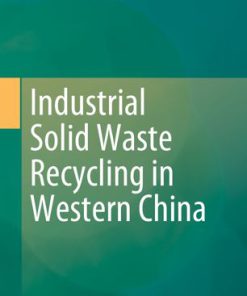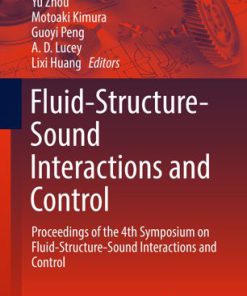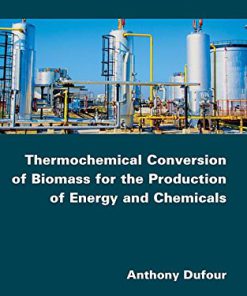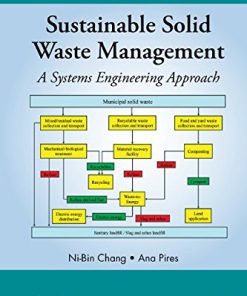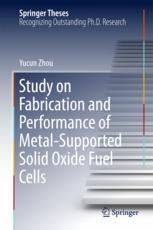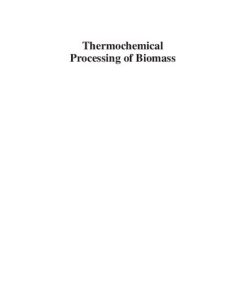Combustible Solid Waste Thermochemical Conversion A Study of Interactions and Influence Factors 1st Edition by Hui Zhou 9811038273 9789811038273
$50.00 Original price was: $50.00.$25.00Current price is: $25.00.
Combustible Solid Waste Thermochemical Conversion A Study of Interactions and Influence Factors 1st Edition by Hui Zhou – Ebook PDF Instant Download/DeliveryISBN: 9811038273, 9789811038273
Full download Combustible Solid Waste Thermochemical Conversion A Study of Interactions and Influence Factors 1st Edition after payment.
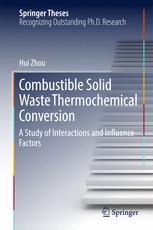
Product details:
ISBN-10 : 9811038273
ISBN-13 : 9789811038273
Author: Hui Zhou
This book is written by Dr. Hui Zhou as a Ph.D. dissertation in Tsinghua University, China. It establishes the thermochemical characteristics of model compounds in combustible solid waste (CSW), and delineates the influence of different factors on the thermochemical characteristics and the influence interactions between model components have on the thermochemical characteristics. The works provide a theoretical basis for the clean and high-efficiency utilization of CSW as well as the basic knowledge for further understanding the thermochemical conversion mechanisms of complex fuels. Researchers and engineers in the field of thermal engineering and environmental engineering can benefit from the book.
Combustible Solid Waste Thermochemical Conversion A Study of Interactions and Influence Factors 1st Table of contents:
1 Introduction
Abstract
1.1 Research Background
1.1.1 Current Situation and Crisis of CSW in China
1.1.2 Components and Trend of CSW in China
1.1.3 The Disposal Methods of CSW
1.1.4 Pollutants from CSW Thermochemical Conversion
1.1.4.1 PCDD/Fs
1.1.4.2 PAHs
1.2 The Research Status of Thermochemical Conversion of CSW
1.2.1 Overview of CSW Thermochemical Conversion Processes
1.2.2 The Research Status of Thermochemical Conversion of CSW Single Components
1.2.2.1 Kinetics
1.2.2.2 Gas, Liquid, and Solid Distribution
1.2.2.3 Gas Production
1.2.2.4 Tar and PAH Formation
1.2.3 The Research Status of Thermochemical Conversion of CSW Multiple Components
1.2.3.1 Kinetics
1.2.3.2 Gas, Liquid, and Solid Distribution
1.2.3.3 Gas Production
1.2.3.4 Tar Formation
1.3 The Research Status of CSW Thermochemical Conversion Reactor
1.3.1 Fix Bed Reactor
1.3.2 Fluidized Bed Reactor
1.3.3 Rotary Kiln Reactor
1.4 Summary of Current Research
1.5 Research Objectives and Main Content
1.5.1 Research Objectives
1.5.2 Main Research Content
1.5.2.1 Basic Component Selection
1.5.2.2 Pyrolytic Characteristic of Basic Components
1.5.2.3 Influential Factors of Thermochemical Conversion of Basic Components
1.5.2.4 Influence of Interactions on Pyrolytic Characteristics of Basic Components
References
2 Research Method
Abstract
2.1 Selection of Basic Components
2.1.1 Classification of CSW
2.1.2 Selection of Basic Components
2.1.3 Basic Characteristics of Basic Components
2.2 Experimental System
2.2.1 TGA-FTIR
2.2.2 Macro-TGA
2.2.2.1 Experimental System
2.2.2.2 Experimental Procedure
2.2.2.3 Experimental System Debugging
2.2.2.4 Influence of Sample Mass and Particle Size
2.2.3 Horizontal Fixed Bed Reactor (HFBR)
2.2.3.1 Experimental System
2.2.3.2 Gas Analysis
2.2.3.3 Analysis of PAHs
2.3 Kinetic Analysis Method
2.3.1 Kinetic Analysis Method of Slow Pyrolysis
2.3.2 Kinetic Analysis Method of Fast Pyrolysis
2.4 Summary
References
3 Pyrolysis Characteristics of Basic Components
Abstract
3.1 Kinetics
3.1.1 Kinetics of Pyrolysis in TGA
3.1.1.1 TG and Derivative Thermogravimetric (DTG) Characteristics
3.1.1.2 Kinetics
3.1.2 Kinetics of Slow Pyrolysis in Macro-TGA
3.1.2.1 TG and DTG Characteristics
3.1.2.2 Kinetics
3.1.3 Kinetics of Fast Pyrolysis in Macro-TGA
3.1.3.1 TG and DTG Characteristics
3.1.3.2 Kinetics
3.1.4 Comparison of Kinetics at Different Conditions
3.1.4.1 Comparison of Slow Pyrolysis in TGA and Macro-TGA
3.1.4.2 Comparison of Slow Pyrolysis and Fast Pyrolysis in Macro-TGA
3.2 Gas, Liquid, and Solid Distribution
3.3 Gas Production
3.3.1 Gas Production in TGA-FTIR
3.3.2 Gas Production in Horizontal Fixed Bed Reactor Fast Pyrolysis
3.4 PAHs Formation
3.5 The Pyrolysis and PAHs Generation Mechanisms of Basic Components
3.6 Summary
References
4 Influential Factors of Thermochemical Conversion of Basic Components
Abstract
4.1 Influence of Temperature
4.1.1 Influence of Temperature on Lignin Pyrolysis
4.1.1.1 Influence of Temperature on Kinetics of Lignin Pyrolysis
4.1.1.2 Influence of Temperature on Product Distribution of Lignin Pyrolysis
4.1.1.3 Influence of Temperature on Gas Production of Lignin Pyrolysis
4.1.1.4 Influence of Temperature on PAHs Formation of Lignin Pyrolysis
4.1.2 Influence of Temperature on PVC Pyrolysis
4.1.2.1 Influence of Temperature on Kinetics of PVC Pyrolysis
4.1.2.2 Influence of Temperature on Product Distribution of PVC Pyrolysis
4.1.2.3 Influence of Temperature on Gas Production of PVC Pyrolysis
4.1.2.4 Influence of Temperature on PAHs Formation of PVC Pyrolysis
4.2 Influence of Heating Rate
4.2.1 Influence of Heating Rate on Lignin Pyrolysis
4.2.1.1 Influence of Heating Rate on Product Distribution of Lignin Pyrolysis
4.2.1.2 Influence of Heating Rate on Gas Production of Lignin Pyrolysis
4.2.1.3 Influence of Heating Rate on PAHs Formation of Lignin Pyrolysis
4.2.2 Influence of Heating Rate on PVC Pyrolysis
4.2.2.1 Influence of Heating Rate on Product Distribution of PVC Pyrolysis
4.2.2.2 Influence of Heating Rate on Gas Production of PVC Pyrolysis
4.2.2.3 Influence of Heating Rate on PAHs Formation of PVC Pyrolysis
4.3 Influence of Atmosphere
4.3.1 Influence of Atmosphere on Lignin Thermochemical Conversion
4.3.1.1 Influence of Atmosphere on Kinetics of Lignin Thermochemical Conversion
4.3.1.2 Influence of Atmosphere on Product Distribution of Lignin Thermochemical Conversion
4.3.1.3 Influence of Atmosphere on Gas Production of Lignin Thermochemical Conversion
4.3.1.4 Influence of Atmosphere on PAHs Formation of Lignin Thermochemical Conversion
4.3.2 Influence of Atmosphere on PVC Thermochemical Conversion
4.3.2.1 Influence of Atmosphere on Kinetics of PVC Thermochemical Conversion
4.3.2.2 Influence of Atmosphere on Product Distribution of PVC Thermochemical Conversion
4.3.2.3 Influence of Atmosphere on Gas Production of PVC Thermochemical Conversion
4.3.2.4 Influence of Atmosphere on PAHs Formation of PVC Thermochemical Conversion
4.4 Influence of Inorganics
4.4.1 Influence of Inorganics on Lignin Pyrolysis
4.4.1.1 Influence of Inorganics on Product Distribution of Lignin Pyrolysis
4.4.1.2 Influence of Inorganics on PAHs Formation of Lignin Pyrolysis
4.4.2 Influence of Inorganics on PVC Pyrolysis
4.4.2.1 Influence of Inorganics on Product Distribution of PVC Pyrolysis
4.4.2.2 Influence of Inorganics on PAHs Formation of PVC Pyrolysis
4.5 The Mechanisms of Lignin and PVC Pyrolysis and PAHs Formation
4.5.1 The Mechanisms of Lignin Pyrolysis and PAHs Formation
4.5.2 The Mechanisms of PVC Pyrolysis and PAHs Formation
4.6 Summary
References
5 Influence of Interactions on the Pyrolytic Characteristics of Basic Components
Abstract
5.1 The Interactions of Lignocellulosic Basic Components
5.1.1 Interacted Effects in TGA-FTIR
5.1.1.1 Influence of Interactions on Kinetics
5.1.1.2 Influence of Interactions on Gas Production
5.1.2 Interacted Effects in Fixed Bed
5.1.2.1 Influence of Interactions on Kinetics
5.1.2.2 Influence of Interactions on Product Distribution
5.1.2.3 Influence of Interactions on Gas Production
5.1.2.4 Influence of Interactions on PAH Formation
5.2 The Interactions of PVC and Lignocellulosic Basic Components
5.2.1 Interacted Effects in TGA-FTIR
5.2.1.1 Influence of Interactions on Kinetics
5.2.1.2 Influence of Interactions on Gas Production
5.2.2 Interacted Effects in Fixed Bed
5.2.2.1 Influence of Interactions on Kinetics
5.2.2.2 Influence of Interactions on Product Distribution
5.2.2.3 Influence of Interactions on Gas Production
5.2.2.4 Influence of Interactions on PAH Formation
5.3 Summary
References
6 Conclusions and Perspectives
Abstract
6.1 Research Conclusions
6.2 Innovative Points
6.3 Perspectives
People also search for Combustible Solid Waste Thermochemical Conversion A Study of Interactions and Influence Factors 1st:
combustible waste container
combustible waste materials
combustible waste disposal
combustible waste code
what is thermochemical conversion of biomass
Tags: Combustible, Solid Waste, Thermochemical Conversion, Interactions, Influence Factors, Hui Zhou
You may also like…
Engineering - Environmental
Industrial Solid Waste Recycling in Western China Fenglan Han
Science (General)
Science (General)
Engineering - Environmental
Sustainable solid waste management A Systems Engineering Approach 1st Edition Ni-Bin Chang
Engineering - Bioengineering




